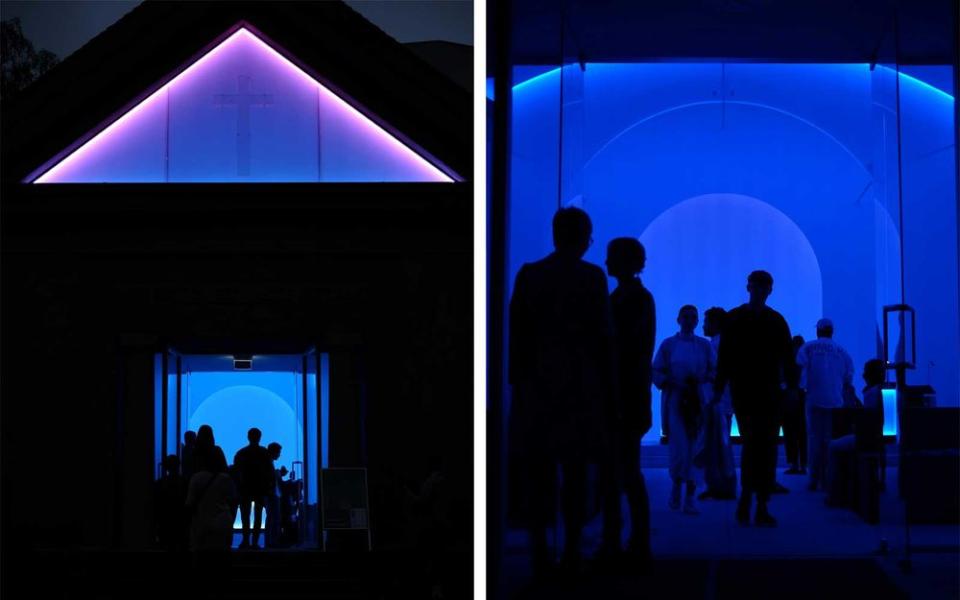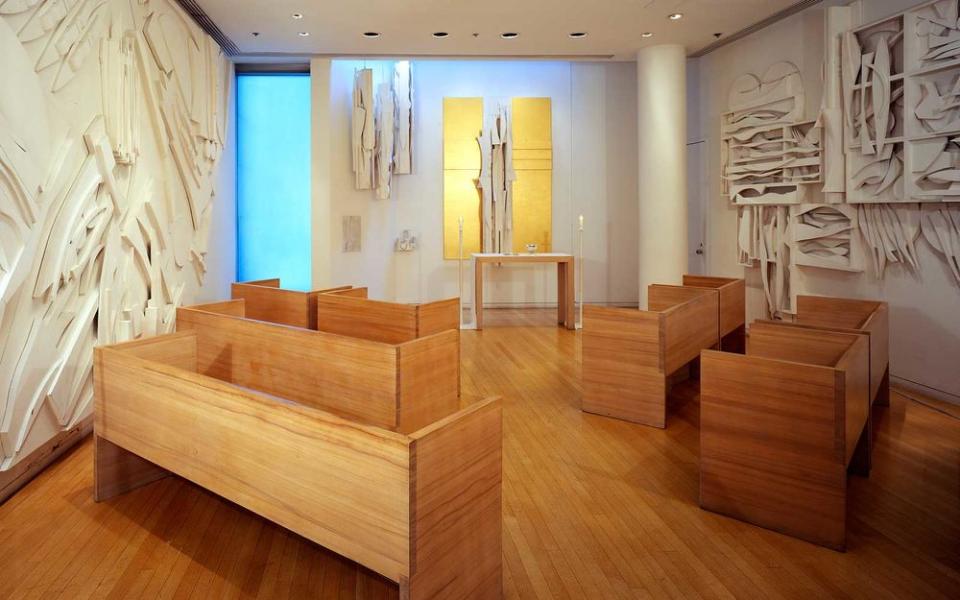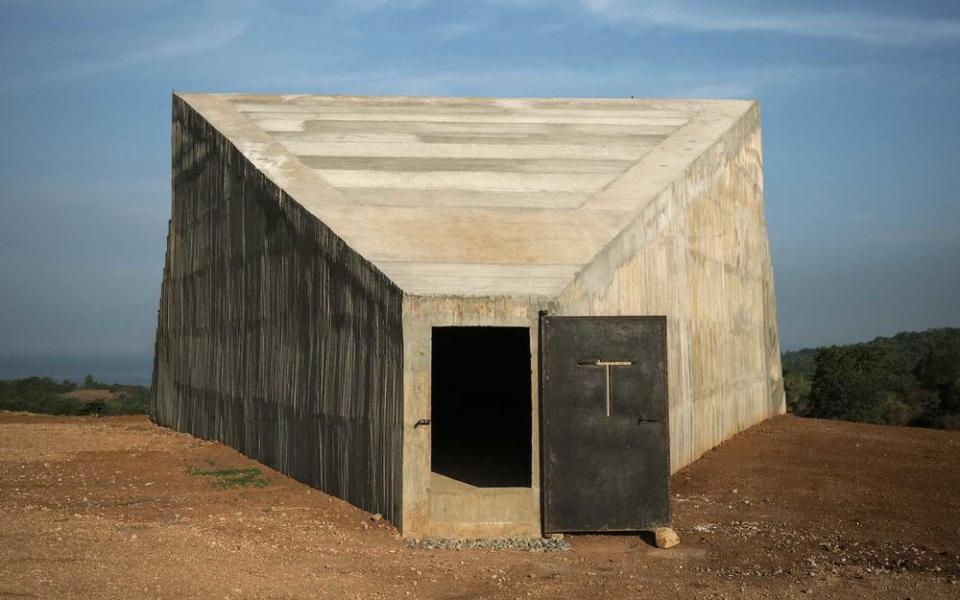These Beautiful Chapels Around the World Are Literal Works of Art
Some 30 years in the making, Ellsworth Kelly’s chapel Austin opened in early 2018 at the Blanton Museum of Art at the University of Austin Texas, where it greets visitors at the south corner of campus. Although Kelly did not live to see the chapel open, the late artist was able to approve every detail of the structure before his death, at age 92, in 2015.
Kelly intended the non-denominational space to be a work of art first and foremost, but “he also wanted it to be a place that was joyful, that was calming, and that you would use for meditation, or truthfully, just going in there and taking a moment away from your day,” said Blanton Museum of Art Director Simone Wicha. Along with Austin, a number of art chapels dot the globe, from Michelangelo’s Sistine Chapel in the Vatican to Mark Rothko’s Rothko Chapel in Houston.
Striking, meditative and often moving — experiencing art in a chapel is different from doing so in a museum or gallery. Here are some of the artist chapels around the globe that combine artistry with worship.
Ellsworth Kelly, Austin, 2015, Austin

“Color is life,” Ellsworth Kelly told Simone Wicha, the director of the Blanton Museum of Art at the University of Texas at Austin, after he signed the deal that finalized the deal to build his monumental final work for the museum. The chapel is indeed filled with color — on three of its sides are a rainbow of windows that bathe its interior in color when the sun shines through.
“When you go in the building and you see those extraordinary colored windows, the world around you to me stops, and you’re just surrounded by this beautiful color,” said Wicha. Kelly titled it Austin, after the city in which it was built (Kelly often titled his pieces after cities). While the chapel non-denominational, in it hangs 14 abstract canvases, each one representing a station of the cross. Austin was influenced by three tropes in his work: his time in France in 1940s where he observed its famous cathedrals (one of the windows is inspired by the rose window at the cathedral in Chartres), his totems, and the spectrum of colors.
Michelangelo, The Sistine Chapel, 1508-1512, the Vatican

Arguably the most famous artist chapel in the world is the Sistine Chapel, located in the Vatican. Renaissance master Michelangelo painted the ceiling of the chapel, which was built between 1477 and 1480 by Pope Sixtus IV, as well as the fresco depicting the Last Judgment on the Sanctuary Wall.
Michelangelo isn’t the only artist whose work is on display there; among the others are Sandro Botticelli, who has a painting up, and Raphael, whose tapestries hang on the wall. Make sure to plan in advance — on a busy day some 25,000 people can walk through its doors, waiting up to four hours to get a glimpse of the Renaissance masterpiece.
James Turrell, Dorotheenstadt Cemetery Memorial Chapel, 2016, Berlin

The legendary light artist James Turrell is known for using natural and artificial light to manipulate viewers’ perceptions of his work, which is on display at countless museums like the De Young in San Francisco, at the tram station at luxury retail destination the Shops at Crystals in Las Vegas, and at Rice University in Houston.
In 2016, Turrell transformed the Dorotheenstadt Cemetery Memorial Chapel into a work of art. As the sun sets, a glowing royal blue light illuminates the space, and then changes color every two minutes for an entire hour. Although the exhibition was only slated to run in 2016, the chapel extended it through spring 2018.
Mark Rothko, Rothko Chapel, 1964–71, Houston

Patrons John and Dominique de Menil asked Mark Rothko to build a meditative space with his paintings in Houston near the site of the Menil Collection. Rothko conceived of an irregular octagon-shaped brick building inscribed in a Greek cross with a baffled skylight that would become known as the Rothko Chapel. Inside hang 14 black, yet color-hued, large-scale canvases by Rothko.
Sadly, Rothko would not live to see its completion; the artist committed suicide in 1970, just before it was finished in 1971. Shortly after in 1973, the Rothko Chapel became a center for colloquiums aimed at fostering mutual understanding of issues affecting justice and freedom around the world. It reopened in 2000 after an 18-month renovation, and was listed on the National Register of Historic Places that year. An estimated 55,000 people visit the Rothko Chapel annually.
Henri Matisse, La Chapelle du Rosaire de Vence, 1948–51, Vence, France

The origins La Chapelle du Rosaire de Vence began when Henri Matisse sought out a nurse to care for him after he was diagnosed with cancer and underwent surgery. Monique Bourgeois got the job and soon after she posed for him, eventually leaving to join a Dominican convent in Vence, where the artist would buy a home. Bourgeois became Sister Jacques Marie, and when visited the artist, telling him about plans to build a chapel beside the girls' high school which the order ran there, and asked Matisse to help design it. He obliged, spending four years on its architecture, stained glass windows, interior furnishings, murals, and the priests' vestments.
Ilise Greenstein, The Sister Chapel, 1978, Glassboro, New Jersey

Ilise Greenstein came up with the idea to build a chapel that represented the Feminist Art Movement, using a play on The Sistine Chapel for the name The Sister Chapel. Thirteen female artists contributed to the piece, which is comprised of 11 panels that feature a monumental figure on a nine-by-five-foot canvas. A circular-shaped ceiling by Greenstein hangs above.
The works on display include a 1976 portrait of lawyer and Women’s Movement figure Bella Abzug by Alice Neel, a 1976 portrait of Joan of Arc by Elsa M. Goldsmith, and a 1976 portrait of Frida Kahlo by Shirley Gorelick. The Sister Chapel made its debut at MoMA PS1 in Long Island City, New York, in 1978, and remained out of sight for years, until 2016, when Rowan University in Glassboro, New Jersey, resurrected the installation, which is still on display there.
Louise Nevelson, The Chapel Of The Good Shepherd at Saint Peter's Church, 1975, New York

Although Louise Nevelson was Jewish, the artist still agreed to take on the commission for this Christian liturgical space. Measuring in at 21 by 28 feet, Nevelson created a monochromatic environment, covering the chapel’s interior in intricate relief sculptures made of wood, and painted the same white as the walls, the exception of the Cross of the Good Shepherd, which is made from white paint and gold leaf. Nevelson imbued the work with Christian references, from the trio of suspended columns on the side of the altar that allude to the Holy Trinity, as well as the titles of the five sculptures that hang on its walls: the Cross of the Good Shepherd, Frieze of the Apostles, Cross of the Resurrection, Grapes and Wheat Lintel and Sky Vestment — Trinity.
Keith Haring, “The Life of Christ” at the AIDS Interfaith Memorial Chapel at Grace Cathedral, 1990, San Francisco

The AIDS Interfaith Memorial Chapel at Grace Cathedral opened in San Francisco in 1995 in response to the crisis caused by the disease that killed some 20,000 in the City by the Bay alone. The Keith Haring Altarpiece: The Life of Christ — a triptych depicting the graffiti-artist-turned-fine-artist’s signature characters as angels that was cast in bronze and covered in gold — was a pivotal acquisition for the project for many reasons, the main one being that it was Haring’s last work before he succumbed to AIDS at age 31 in 1990. Haring created the altarpiece in an edition of nine plus two artist’s editions. Another is on display at St. John the Divine in New York City.
Le Corbusier, Notre Dame du Haut, Ronchamp, France, 1954

French polymath Le Corbusier was several things — an artist, architect and designer among them. The Association de l'?uvre Notre Dame du Haut asked him to design a chapel after the original one on the site was destroyed during World War II. Constructed of concrete and stone, the chapel features a white exterior and grey curved, sculptural roof.
Inside, the south wall features small, minimal, rectangular stained-glass windows with sloping openings that allow light to enter at varying degrees and add pops of jewel-toned color to the interior. Le Corbusier also filled the insides of the south wall with rubble from the original chapel. Thieves broke into the chapel on Jan. 17, 2014, breaking the only stained-glass window designed by Le Corbusier that carried his signature.
Not Vital, Untitled, 2017, Saysain, Philippines

Bataan, a province in the Philippines best known for being the site of the infamous Bataan Death March of World War II got its very own art shrine in Saysain last year when Swiss artist Not Vital erected a breathtaking concrete chapel atop a sweeping hill overlooking the South China Sea. Although the Philippines is a deeply religious place — 86 percent of Filipinos are Roman Catholic — Vital’s chapel is not consecrated, despite his abstract rendition of The Last Supper on that hangs above the water-filled floor on the back wall.
On one side, Vital pays homage to its location through the rice goddess Bulol that hangs there. The chapel may be remote, but go to Las Casas Filipinas de Acuzar, a resort filled with restored Spanish colonial homes, and also one of the locations of Bellas Artes Projects, the non-profit art organization that oversaw the project, and they will point you in the right direction